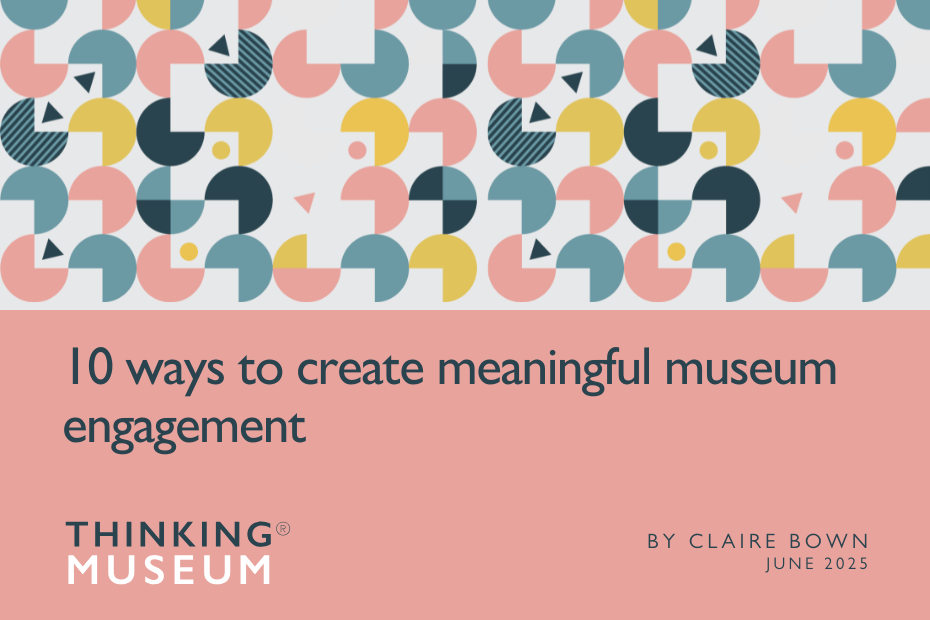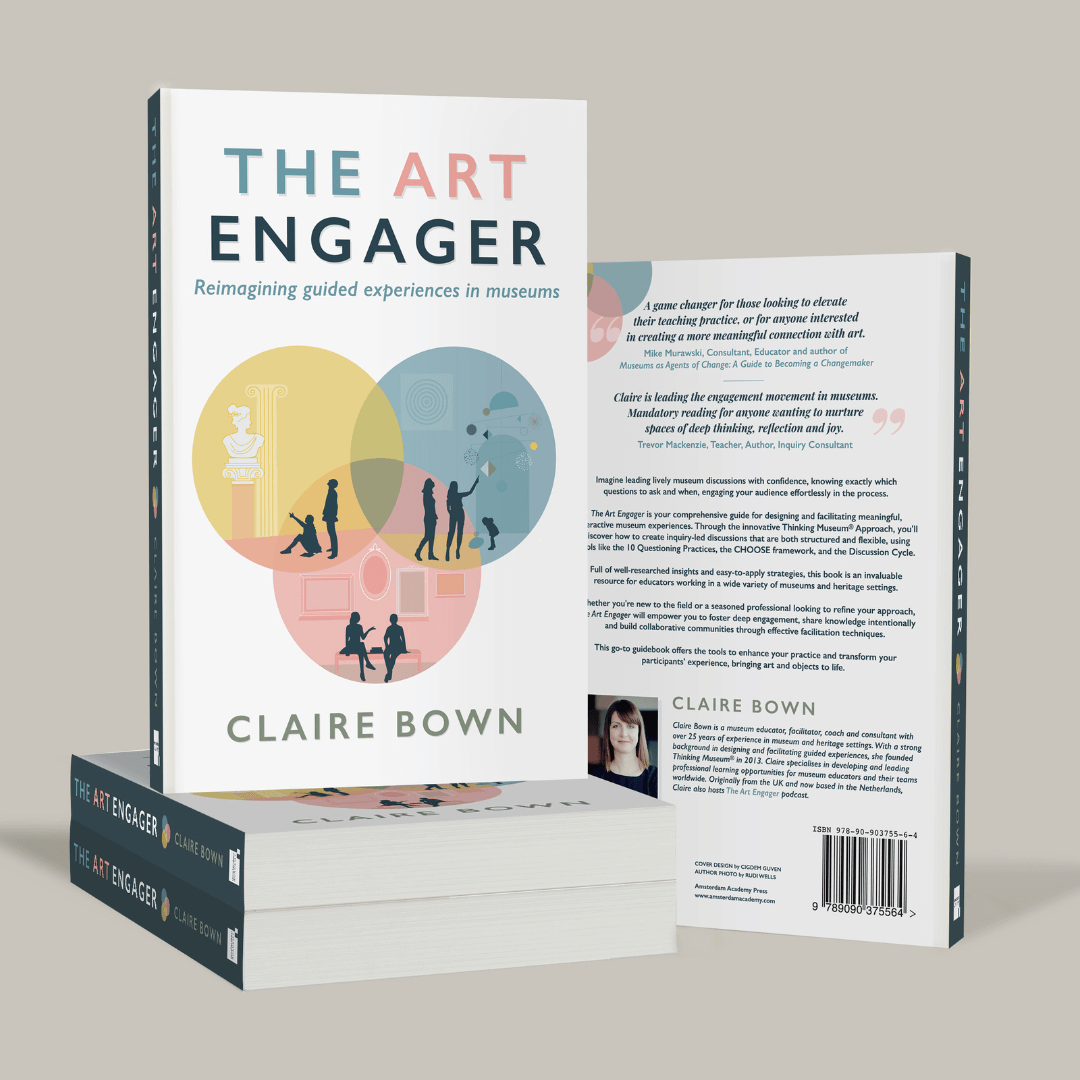After 150 episodes exploring engagement in museums and cultural organisations – including 101 solo episodes and 49 guest conversations – I’m sharing the 10 most powerful insights that have emerged from four years of exploring engagement principles and practices.
I’ve combed through the entire back catalogue, re-listening to episodes and looking for the patterns that keep coming up again and again.
The common thread running through all these insights is how small changes can dramatically improve engagement. Each one offers something concrete you can try in your next session.
Four years and 150 episodes distilled into these 10 insights for consistently creating meaningful engagement.
Support The Art Engager podcast on Patreon.
1. Engagement begins with observation and noticing
In today’s world, we’ve become too accustomed to superficial observation. Our attention is fragmented and disrupted by technology. We scan, we skim, and we scroll, missing the subtleties and details that enrich our understanding of our surroundings.
In guided experiences, we can offer opportunities for participants to observe, notice, and deeply engage with art and objects. We can encourage and cultivate heightened awareness and attention to detail using all of the senses to connect with what we’re looking at.
Why it matters: Without noticing details, there is no shared discovery. Objects don’t share all their secrets at first glance. Different layers of meaning and nuance are revealed during sustained observation and noticing.
Try this: By encouraging participants to observe and describe the details of an artwork or object, you’re laying the foundation for deeper interpretation and critical thinking.
This principle stands out as the most fundamental and straightforward piece of engagement advice. If museum educators could only implement one strategy, this would be the most valuable choice time and time again.
2. Not all questions are created equal
Ask any museum educator about engagement, and they’ll mention questions as the cornerstone of any engaging museum programme. But there’s more to it than you might think.
Good questioning technique and well-worded, thoughtful questions can instantly engage people, provoke curiosity, find out what participants already know, and make programmes more interactive. But questions can also work against you.
The challenge: Few of us receive training in creating and sequencing questions. Using questions in an organised way, gradually building each question on the previous one, is essential in balanced discussion but difficult to master.
The solution: Questioning Practices – structures designed specifically for museum educators to actively and intentionally support question use whilst fostering participation and engagement.
Why it works: When we’re intentional about our questions, we create better conditions for meaningful experiences. This focus on questioning has featured across roughly 8% of all podcast episodes, highlighting its crucial importance in transforming entire experiences.
3. Connection before content
Connection before content is a phrase that comes up repeatedly as the key takeaway for participants in museum education workshops. This principle, originally from organisational designer Peter Block, means making a conscious effort to:
- Connect people to each other – help the group feel like a community
- Build genuine rapport between yourself as facilitator and participants
- Help visitors connect to the museum space and its collection
- Clarify the purpose of your time together
- Create a warm, welcoming atmosphere where everyone feels they belong
The mindset shift: Putting connection before content might feel counterintuitive when you have limited time with groups. Many worry that spending time on connection means sacrificing content or running out of time for sharing background knowledge.
The reality: When people feel connected, they actually listen more attentively, participate more actively, and remember information better. The time spent building connection is more than made up for by improved quality of engagement with the content you do share.
4. Silence creates space for thinking
In museum programmes, we often feel pressure to fill every moment with words. We might rush to answer our own questions, fill every gap, and move quickly from one point to the next. But silence is one of the most powerful tools in our engagement toolkit.
When we ask a thoughtful question and allow that silence to stretch – what we might call ‘productive silence‘ – we’re creating space for participants to look, to think, and to formulate their own responses.
What productive silence creates:
- Space for deeper observation
- Time for personal connections
- More thoughtful comments than if we rush to fill the void
- Respect for people’s thinking processes
Overcoming discomfort: Many of us find silence uncomfortable, worrying that participants are bored, confused, or expecting us to keep talking. But participants actually appreciate small moments to process what they’re seeing and thinking.
Becoming comfortable with silence takes practice, but it transforms the quality of discussions and shows genuine respect for people’s thinking processes.
5. Psychological safety unlocks deeper participation
Museums can be imposing spaces with their grand architecture, (sometimes) hushed atmospheres, complex layouts, and unspoken codes of behaviour. Even museum professionals can feel intimidated in these environments. Imagine being a participant in a guided experience where you’re not only processing these feelings, but also being asked to speak up in front of strangers.
It’s no wonder many visitors default to silence or safe, superficial responses. This is where psychological safety becomes crucial.
What it means: Creating an environment where people feel it’s okay to ask questions, take risks, and share perspectives without fear of judgement or embarrassment.
Why it matters: Without psychological safety, even the most brilliant questions or amazing artworks may be met with surface-level engagement or silence.
Small actions, big difference:
- Welcome people individually
- Validate early contributions
- Explicitly state that there are no wrong answers
- Model curiosity rather than certainty
- Respond to all comments with genuine interest
6. Every challenge is an opportunity
In museum work, challenges inevitably arise—from the dreaded “tumbleweed moment” when a question falls flat, to groups that seem reluctant to participate. Museum spaces are full of unpredictable moments.
Whilst we can’t always control what happens during guided experiences, we can choose to view those moments through a lens of possibility.
The experimental mindset: When we adopt an experimental mindset, we change “problems” into questions:
- What might this silence be telling me about my pacing?
- How might this resistance reveal what the group actually needs?
The learning opportunity: The most skilled facilitators don’t just solve problems—they approach challenges with genuine curiosity, asking what they can learn from each situation.
Challenges become drivers of positive change and improvement, pushing us to try new approaches, develop new skills, and advance our practice in ways that might not happen when everything runs smoothly.
7. Engagement happens through multiple channels
How many ways can we connect with art and objects? Far more than just through discussion and observation. Whilst we often think of engagement in museums as primarily verbal, engagement actually flows through our senses, our bodies, our emotions, and our creativity.
Beyond verbal engagement:
- Drawing to reveal details our eyes might otherwise miss
- Creative writing to forge personal connections with artworks
- Slow listening experiences with music to develop deeper attention
- Using smell to evoke memories and emotions
- Movement to help participants understand form and composition through their bodies
Multimodality principle: This is about offering a wide variety of options to help participants engage with programmes. It’s less about pleasing all people all the time, and more about providing various aids, activities, and modes of working in any session to appeal to as many participants as possible.
These multimodal approaches enrich everyone’s experience, not just those with specific learning preferences.
8. Less information leads to more understanding
Many museum educators feel responsible to share knowledge—providing visitors with historical context, technical details, and background information. This impulse comes from a good place: wanting visitors to appreciate the significance of what they’re seeing.
The problem: Information overload is the enemy of genuine understanding. When we shower visitors with facts, dates, and details before they’ve had a chance to look, think, and wonder, we often achieve exactly the opposite of what we intend.
Why less works better: Most people forget information when they haven’t been challenged to think about it first or connect it to what they already know. Less information, strategically shared, actually leads to deeper understanding.
The principle: Strategic information sharing prevents overload and allows for deeper comprehension. There are practical frameworks available to help decide exactly what information to share and what to leave out.
9. Deliberate practice is how we grow
Being good at engaging people with art and objects isn’t something that happens overnight. Like any skill worth mastering, it develops through practice, reflection, and continuous refinement.
What deliberate practice involves:
- Watching others at work and noticing specific details
- Creating opportunities to practice in low-stakes settings
- Recording reflections systematically and looking for patterns over time
- Setting specific goals for growth
The reflection cycle: Regular reflection transforms practice. After each programme, asking three key questions creates a powerful cycle of improvement: what went well, what could have been done differently, and what to try next time.
What sets exceptional facilitators apart: It’s not necessarily what they know, it’s their commitment to ongoing cycles of practice, reflection, and adjustment. They see each programme not as a performance to perfect, but as another opportunity to learn, grow, and develop.
10. Engagement happens by design, not by chance
Creating meaningful engagement in museums doesn’t happen by accident. It requires thoughtful design, careful planning, and purposeful execution.
What thoughtful design considers:
- The entire visitor journey from initial welcome to final moments
- The physical route through the museum
- The pacing of activities
- The balance of listening and participating
- Transitions between stops
How it works: When you plan a guided experience with intention, each element works together harmoniously. The route tells a story, questions build upon one another, activities deepen engagement progressively, and conclusions help participants integrate discoveries and extend thinking beyond museum walls.
The outcome: This creates conditions for engagement deliberately, rather than leaving meaningful connection to chance.
The power of small changes
The most remarkable thing about these 10 insights is how small shifts can lead to really big changes. Something as simple as giving people 30 seconds to really look, pausing after asking a question, or spending a moment connecting with people before diving into content—these tiny adjustments can completely transform an experience.
Small, intentional changes in how we observe, question, connect, and design our programmes create the kind of meaningful engagement that stays with people long after they’ve left the museum.
Looking for more insights like these? The Art Engager podcast features 150 episodes of practical strategies and expert conversations for museum educators. Find it wherever you listen to podcasts.
The Art Engager: Reimagining Guided Experiences in Museums
Whether you’re new to the field or a seasoned museum educator looking to refine your approach, The Art Engager is your go-to guidebook for creating the ultimate visitor experience.
Full of well-researched insights and easy-to-apply strategies, this book is an invaluable resource for educators working in a wide variety of museums and heritage settings.

